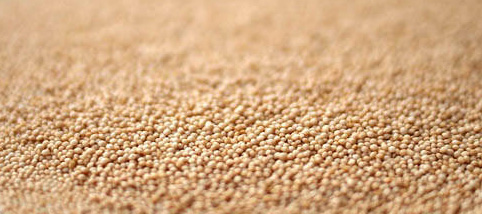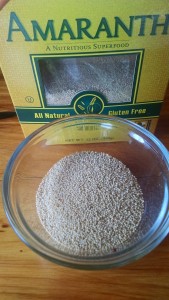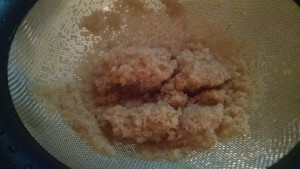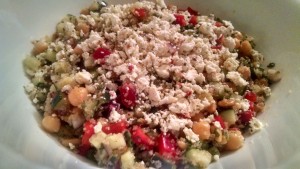 Amaranth, having the dimension of the tiniest of seeds, a/k/a brown caviar, has a prestigious historical, nutritional and culinary profile that is worth adding to your ancient grain “toolchest” of knowledge.
Amaranth, having the dimension of the tiniest of seeds, a/k/a brown caviar, has a prestigious historical, nutritional and culinary profile that is worth adding to your ancient grain “toolchest” of knowledge.
History-Amaranth has been in the history books for thousands of years, most notably identified with the Pre-Columbian Aztecs. Pre-Columbian literally denotes that time before Christopher Columbus’s voyage in 1492 and before significant European influences on the American continents. It turns out Amaranth was not only a dietary staple of the Aztecs but was also a pivotal component of their religious rituals. Amaranth was mixed with honey and yes, unfortunately sometimes, human blood, to make ceremonial “cookies”. It was not unlike the Amaranth seed skull that follows, currently used in the “Day of the Dead” celebration in Mexico:
In the 16th century Cortez landed in the New World with his army of men and made forceful attempts to convert the Aztecs to Christianity. One of his first edicts was to eradicate any foods that were associated with non-Christian ceremonies and Amaranth was at the top of the list. But as we know from the history of Prohibition, even though punishment was severe for anyone growing or possessing Amaranth, the human spirit always prevails for the coveted seed eventually spread like wild-fire all over the world!
Nutrition–Amaranth is both gluten-free and easily digestible. That is a real plus for those of you suffering from celiac disease, transitioning from a fast or cleanse or recovering from an illness. Out of the trifecta of gluten-free grains, that is amaranth, quinoa and buckwheat, amaranth has the highest protein count, coupled with a high fiber content on par with quinoa:
Remember, a higher protein and fiber count will give you that feeling of satiety and keep you from coming back for more. Amaranth, unlike grains in general, is more of a complete protein since it contains the essential amino acids methionine and lysine. This is a true concern for vegans, complete proteins are a must. For more on general nutrition information of ancient grains see Discover the Goodness of Ancient Grains.
Preparation-First, rinse off the amaranth with water in a fine sieve. No need to presoak amaranth, it has a relatively small cooking time. There are three methods in general for cooking grains:
1.) Simmering-Bring liquid and grain to a boil and simmer with a cover.
2.) Pilaf– This method is akin to braising. Coat the grain with a heated fat and onion mixture then add broth and finish the product in the oven.
3.) Risotto-This is a combination of both simmering and pilaf methods.
The only method that really works for Amaranth because of it’s consistency, is the simmering method outlined below:
Simmering-
- Combine the grain with the proper amount of liquid. Note this depends on the type of grain.
- Bring the grain and liquid mixture to a boil.
- Turn the heat to low and simmer with the lid on until desired consistency is achieved.
My recommendation is to use either only low sodium broth, like vegetable and chicken or a ½ broth ½ water mixture instead of only water. It gives the grains a definite flavor boost!
Three things to remember for Amaranth:
1. Liquid/Grain Ratio-The ratio of liquid to Amaranth is about about three to one. In Amaranth’s case especially, it’s better to error on the side of more liquid or you will end up with a gloppy mess!
2. Fine Sieves are Key-The Amaranth seed is so tiny, a fine sieve is mandatory for preparation. Just pour the amaranth into a fine sieve after simmering, usually about 20 minutes. You will note the gelatin-like consistency of Amaranth after cooking:
Don’t be alarmed for the liquid has just absorbed the starch in the grain. Just pour the cooked amaranth into a fine sieve and rinse with water. Then use the rinsed amaranth in your cooking preparation:
3. Special “Popped” Option– You can also enjoy Amaranth by itself or combined with milk and honey for breakfast after “popping” it. Pour in one tablespoon at a time (experiment with this yourself, you’ll see large quantities burn easily) in a dry saucepan and “pop” the seed. Then add the ingredients of your choice for a nutritious breakfast.
Menu Idea & Recipe– This is always my favorite part. Actually transforming a raw, high quality, non-refined and nutritious product, in this case, the ancient grain Amaranth, into a delicious menu item! The salad that follows is a refreshing side for any meal but is made even more remarkable with fresh cucumbers, red pepper, parsley and mint from your garden!
TABBOULEH-STYLE AMARANTH SALAD
Servings: 4-6
Ingredients:
1 ½ cups cold water or vegetable or chicken broth
½ cup uncooked whole-grain amaranth
2 cups diced unpeeled cucumber
½ cup thinly sliced celery
½ cup finely chopped red onion
¼ cup chopped fresh mint
¼ cup chopped fresh flat-leaf parsley
¼ cup pine nuts, toasted
2 T extra-virgin olive oil
1 tsp. grated lemon rind
2 T. fresh lemon juice
¼ tsp. salt
¼ tsp. crushed red pepper
½ cup drained no-salt canned chickpeas
1 cup feta cheese, crumbled
Lemon wedges-optional
Procedure:
- Bring 1½ cup broth or cold water and amaranth to a boil in a medium saucepan; reduce heat, cover and simmer 20 minutes or until water is almost absorbed (it will have a mushy appearance).
- While amaranth cooks, combine cucumber and next 11 ingredients in a large bowl.
- Place amaranth in a fine sieve and rinse under cold runner water until room temperature; drain well, pressing with the back of a spoon. Add the cucumber mixture; toss to blend. Add cheese; toss gently. Garnish with lemon wedges if desired.
*Recipe from MyRecipes.com
Watch for my next Ancient Grain post; the 2nd in the trifecta I’m introducing of gluten-free grains:
Quinoa!






